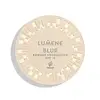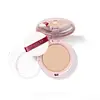What's inside
What's inside
 Key Ingredients
Key Ingredients

 Benefits
Benefits

 Concerns
Concerns

 Ingredients Side-by-side
Ingredients Side-by-side

Talc
AbrasiveZinc Oxide
Cosmetic ColorantBoron Nitride
AbsorbentMica
Cosmetic ColorantMagnesium Stearate
Cosmetic ColorantSilica
AbrasiveHydrogenated Castor Oil
EmollientZinc Stearate
Cosmetic ColorantCaprylyl Methicone
Skin ConditioningOctyldodecyl Stearoyl Stearate
EmollientPhenyl Trimethicone
Skin ConditioningRubus Chamaemorus Seed Oil
Skin ConditioningCaprylyl Glycol
EmollientEthylhexyl Palmitate
EmollientPhenoxyethanol
Preservative1,2-Hexanediol
Skin ConditioningJojoba Esters
EmollientEthylhexylglycerin
Skin ConditioningTocopherol
AntioxidantHelianthus Annuus Seed Oil
EmollientTriethoxycaprylylsilane
Silica Dimethyl Silylate
EmollientButylene Glycol
HumectantSodium Hyaluronate
HumectantHexylene Glycol
EmulsifyingRosmarinus Officinalis Leaf Extract
AntimicrobialIron Oxides
CI 77891
Cosmetic ColorantTalc, Zinc Oxide, Boron Nitride, Mica, Magnesium Stearate, Silica, Hydrogenated Castor Oil, Zinc Stearate, Caprylyl Methicone, Octyldodecyl Stearoyl Stearate, Phenyl Trimethicone, Rubus Chamaemorus Seed Oil, Caprylyl Glycol, Ethylhexyl Palmitate, Phenoxyethanol, 1,2-Hexanediol, Jojoba Esters, Ethylhexylglycerin, Tocopherol, Helianthus Annuus Seed Oil, Triethoxycaprylylsilane, Silica Dimethyl Silylate, Butylene Glycol, Sodium Hyaluronate, Hexylene Glycol, Rosmarinus Officinalis Leaf Extract, Iron Oxides, CI 77891
Mica
Cosmetic ColorantSilica
AbrasiveDimethicone
EmollientBoron Nitride
AbsorbentVinyl Dimethicone/Methicone Silsesquioxane Crosspolymer
Nylon-12
Phenyl Trimethicone
Skin ConditioningCaprylyl Glycol
EmollientTriethoxycaprylylsilane
Dimethicone/Vinyl Dimethicone Crosspolymer
Skin Conditioning1,2-Hexanediol
Skin ConditioningEthylhexylglycerin
Skin ConditioningAllantoin
Skin ConditioningWater
Skin ConditioningJojoba Esters
EmollientTocopheryl Acetate
AntioxidantButylene Glycol
HumectantHibiscus Sabdariffa Flower Extract
Skin ConditioningAloe Barbadensis Leaf Extract
EmollientCarthamus Tinctorius Flower Extract
Skin ConditioningChrysanthellum Indicum Extract
Skin ConditioningLonicera Japonica Flower Extract
Skin ConditioningNelumbo Nucifera Flower Extract
Skin ConditioningPhenoxyethanol
PreservativeSodium Hyaluronate
HumectantTitanium Dioxide
Cosmetic ColorantCI 77492
Cosmetic ColorantCI 77491
Cosmetic ColorantCI 77499
Cosmetic ColorantMica, Silica, Dimethicone, Boron Nitride, Vinyl Dimethicone/Methicone Silsesquioxane Crosspolymer, Nylon-12, Phenyl Trimethicone, Caprylyl Glycol, Triethoxycaprylylsilane, Dimethicone/Vinyl Dimethicone Crosspolymer, 1,2-Hexanediol, Ethylhexylglycerin, Allantoin, Water, Jojoba Esters, Tocopheryl Acetate, Butylene Glycol, Hibiscus Sabdariffa Flower Extract, Aloe Barbadensis Leaf Extract, Carthamus Tinctorius Flower Extract, Chrysanthellum Indicum Extract, Lonicera Japonica Flower Extract, Nelumbo Nucifera Flower Extract, Phenoxyethanol, Sodium Hyaluronate, Titanium Dioxide, CI 77492, CI 77491, CI 77499
Ingredients Explained
These ingredients are found in both products.
Ingredients higher up in an ingredient list are typically present in a larger amount.
1,2-Hexanediol is a synthetic liquid and another multi-functional powerhouse.
It is a:
- Humectant, drawing moisture into the skin
- Emollient, helping to soften skin
- Solvent, dispersing and stabilizing formulas
- Preservative booster, enhancing the antimicrobial activity of other preservatives
Boron Nitride is compound consisting of boron and nitrogen. It is used to absorb oil and modify adherence/ slip in products.
This means it is often used in makeup products to help them last longer.
Butylene Glycol (or BG) is used within cosmetic products for a few different reasons:
Overall, Butylene Glycol is a safe and well-rounded ingredient that works well with other ingredients.
Though this ingredient works well with most skin types, some people with sensitive skin may experience a reaction such as allergic rashes, closed comedones, or itchiness.
Learn more about Butylene GlycolCaprylyl Glycol is a humectant and emollient, meaning it attracts and preserves moisture.
It is a common ingredient in many products, especially those designed to hydrate skin. The primary benefits are retaining moisture, skin softening, and promoting a healthy skin barrier.
Though Caprylyl Glycol is an alcohol derived from fatty acids, it is not the kind that can dry out skin.
This ingredient is also used as a preservative to extend the life of products. It has slight antimicrobial properties.
Learn more about Caprylyl GlycolEthylhexylglycerin (we can't pronounce this either) is commonly used as a preservative and skin softener. It is derived from glyceryl.
You might see Ethylhexylglycerin often paired with other preservatives such as phenoxyethanol. Ethylhexylglycerin has been found to increase the effectiveness of these other preservatives.
Jojoba Esters is a wax created from Jojoba oil. It is an emollient and film-forming ingredient. In bead form, it is an exfoliator.
This ingredient has high oxidative stability, meaning it doesn't break down when exposed to oxygen.
Its similarity to our skin's natural oils makes it a great emollient. Emollients help soften and soothe our skin by creating a barrier on top. This barrier helps trap moisture in, keeping skin hydrated.
It is created using either the hydrogenation or transesterification processes on jojoba oil.
Learn more about Jojoba EstersMica is a naturally occurring mineral used to add shimmer and color in cosmetics. It can also help improve the texture of a product or give it an opaque, white/silver color.
Serecite is the name for very fine but ragged grains of mica.
This ingredient is often coated with metal oxides like titanium dioxide. Trace amounts of heavy metals may be found in mica, but these metals are not harmful in our personal products.
Mica has been used since prehistoric times throughout the world. Ancient Egyptian, Indian, Greek, Roman, Aztec, and Chinese civilizations have used mica.
Learn more about MicaPhenoxyethanol is a preservative that has germicide, antimicrobial, and aromatic properties. Studies show that phenoxyethanol can prevent microbial growth. By itself, it has a scent that is similar to that of a rose.
It's often used in formulations along with Caprylyl Glycol to preserve the shelf life of products.
Phenyl Trimethicone is a silicon-based polymer. It is derived from silica.
Phenyl Trimethicone is used as an emollient and prevents products from foaming.
As an emollient, it helps trap moisture in the skin. It is considered an occlusive.
Learn more about Phenyl TrimethiconeSilica, also known as silicon dioxide, is a naturally occurring mineral. It is used as a fine, spherical, and porous powder in cosmetics.
Though it has exfoliant properties, the function of silica varies depending on the product.
The unique structure of silica enhances the spreadability and adds smoothness, making it a great texture enhancer.
It is also used as an active carrier, emulsifier, and mattifier due to its ability to absorb excess oil.
In some products, tiny microneedles called spicules are made from silica or hydrolyzed sponge. When you rub them in, they lightly polish away dead skin layers and enhance the penetration of active ingredients.
Learn more about SilicaSodium Hyaluronate is hyaluronic acid's salt form. It is commonly derived from the sodium salt of hyaluronic acid.
Like hyaluronic acid, it is great at holding water and acts as a humectant. This makes it a great skin hydrating ingredient.
Sodium Hyaluronate is naturally occurring in our bodies and is mostly found in eye fluid and joints.
These are some other common types of Hyaluronic Acid:
Learn more about Sodium HyaluronateTriethoxycaprylylsilane is a silicone used to bind and stabilize ingredients.
As an emulsifier, it helps prevent ingredients from separating. This can help elongate the shelf life of products.
Triethoxycaprylylsilane is often used to coat mineral sunscreens ingredients to help give a better feel. It also helps reduce oxidative stress in sunscreens.
Learn more about Triethoxycaprylylsilane